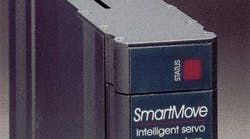Increasingly, drives must position a part as well as control the speed and direction of shaft rotation. This is especially true for indexing, pick-and-place, and cut-tolength applications.
Traditionally, servo systems (servo drive and motor) have provided position control through adjustable-speed drives. Their main drawback is cost. So many engineers are turning to ac drive technology and ac systems to control position. Their performance is nearly as good as that of servo systems, but at lower cost.
Servo positioners
A typical servo system consists of a dc brush or brushless drive and motor with feedback for closed-loop control. A PLC or PC controller tells the drive the speed and direction plus the elapsed time to move a part from one location to another.
A tachometer-generator (tach) usually supplies motor speed feedback to the controller while an encoder or resolver provides position data for the motor or part being moved. Based on this input, the controller adjusts current to the motor so that the actual and intended positions coincide. In some cases, an encoder supplies both speed and position feedback.
Dc servomotors are usually chosen because they are smaller and lighter than ac versions, and they have low-inertia rotors. As a result, a dc servo can accelerate and decelerate a load faster (up to 4,000 rad/sec2) and position it more accurately than an ac drive. Brushless dc drives are commonly used for precision applications of less than 20 hp.
AC vector drives
Most general-purpose ac adjustable- speed drives don't have position control. However, vector controlled, pulse width modulated (PWM) drives are an exception. These drives use regulators with microprocessors and DSPs that improve drive response and position regulation.
Vector drives with built-in position controllers operate ac induction or permanent-magnet synchronous motors, and they can produce 100% of full torque at zero speed. Like dc servos, these ac drives incorporate both speed and position feedback loops. Therefore, they can also be considered servos.
For applications that require less accuracy than that of a traditional servo system, an ac vector drive with an induction motor and encoder can replace a low end servo system for about half the cost. Moreover, ac induction motors are simple and reliable, which means low maintenance.
Positioning applications that require drives of 20 hp or more increasingly are using newer ac vector drives. Examples include indexing and sorting, pick-and-place, cut-tolength, palletizing, machining (grinding), and packaging equipment.
Inside story
A vector drive gets its position control capabilities from a built-in control card or intelligent motion controller. Typically, this device can be programmed to set motion profiles plus home and absolute positions based on encoder pulses. The card fits inside a standard drive enclosure, so it requires no extra space or wiring.
Using a built-in unit eliminates the D-to-A and A-to-D signal conversions that take place with standalone devices. Digital signals between the motor control and motion controller eliminate both conversion time and noise (errors).
Such controllers also ease the burden on system PLCs. For example, some adjustable-speed drives rely on a series of limit switches or proximity sensors to aid in accelerating or decelerating to a stop. These sensors signal changes in motor speed at different points along the motion path (high-speed start, reduced speed when approaching target position, zero speed at target). A PLC monitors all of these sensors as well as encoder positions, and sends signals to the drive. A built-in controller eliminates the need for these sensors, making it possible to use a smaller PLC, and delivers more accurate speed and position control.
Information for this article was provided by R.J. DiMaggio of Baldor Electric Co., Jeff Duncan of Danfoss Inc., Brian Macomber of Reliance Electric, and Bart de Vries of Saftronics Corp.
